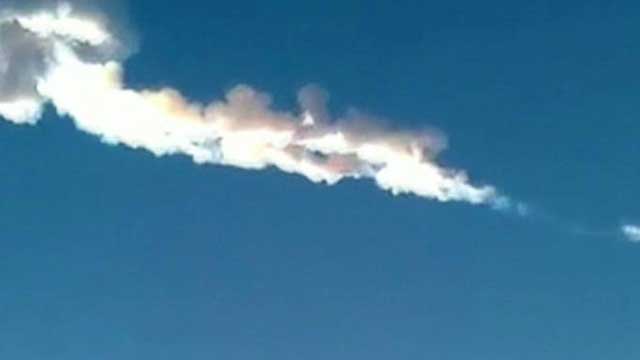It turns out the meteor that landed in Russia last week was a bit bigger than the 10 tons first reported. About 1,000 times bigger.
When a hunk of rock raced out of the morning skies over Russia on Friday and exploded with nearly 500 kilotons of energy, early size estimates from the Russian Academy of Sciences that were carried by the Associated Press, Reuters and other news wires pegged it on the small size, with a weight of about 10 tons.
Oops.
'This event was so much bigger than anything we've seen on video that it doesn't surprise me the guess was off by three orders of magnitude.'
Later in the evening, after studying infrasound data from stations around the world, NASA released a new estimate revising that first guess upward by a thousand-fold: The meteorite actually weighed closer to 10,000 tons, scientists said -- approximately as much as 170 M1 Abrams tanks.
“My guess is that someone eyeballed the videos and made an educated guess,” said Margaret Campbell-Brown, associate professor in the department of physics and astronomy at the University of Western Ontario. “This event was so much bigger than anything we've seen on video that it doesn't surprise me the guess was off by three orders of magnitude.”
- Higgs boson find may spell doom for universe
- Fire in the sky: Nearly 1,100 injured as meteor falls in Russia
- Has dark matter finally been found? Big news coming
- Russian meteor blast ‘heard’ around the world
- Russian meteorite: Why didn’t scientists see it coming?
- ‘Stratospheric’ prices for Russian meteor fragments
That poor estimate underscores the daunting task scientists face today: While NASA’s Near-Earth Object Program currently tracks about 10,000 objects through the heavens, there are far, far more smaller objects that are simply too tiny to track.
“If you think about objects the size of the one that came into Russia, you’re probably looking at 100 million up there. Of those likely to intersect Earth, there’s less, maybe 100,000,” said K.T. Ramesh, director of the Hopkins Extreme Materials Institute and a professor of mechanical engineering at Johns Hopkins. “Space is pretty big.”
And the size of those smaller objects -- whether they’re 10 tons or 10,000 tons -- makes them impossible to track with current technology, he said.
“In general, we're pretty good at seeing things that are 1 kilometer and up in diameter, and have trouble seeing things that are less than 100 meters in diameter. The big problem is knowing where they are -- once you know where to look, you can find even the smaller objects,” he said.
For comparison, NASA currently believes the Russian meteorite was about 49 feet in diameter, or 15 meters. (Asteroid 2012 DA14, which NASA tracked on its flight near our planet on Friday, was approximately 150 feet in diameter, or 45 meters.)
“A good analogy is finding a few pennies scattered over an acre of dirt. If you know where to look, you have no trouble seeing them. But if you just look over the whole field, your chance of finding a penny is pretty small,” Ramesh told FoxNews.com.
Without sensors aimed directly at the incoming meteor, initial data was scarce. As other bits of data came in, scientists were able to hone their estimates of the size of the meteor, explained Edwin Bergin with the University of Michigan’s Department of Astronomy.
“Reports say that the network used to detect and infer nuclear explosions led to the revision,” he told FoxNews.com. “I think it just is better information that took time to filter out.”




















